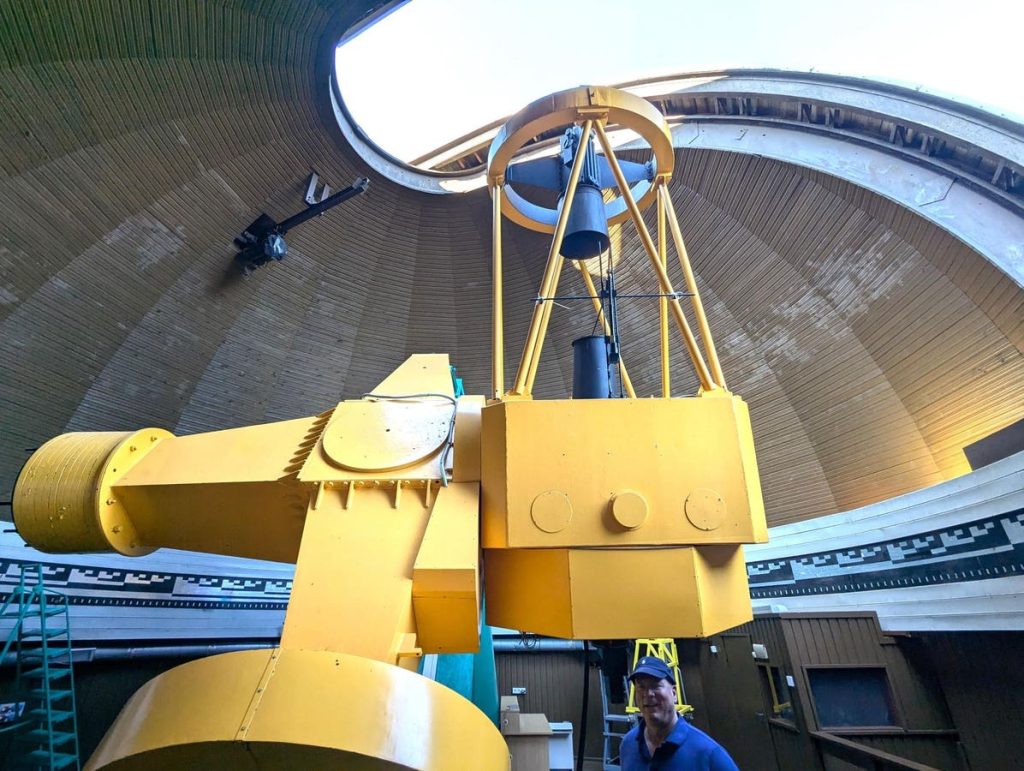The old adage that we are stardust is literally true. But is there a link between a star’s given chemical composition and the types of planets it may form?
For almost a decade now, a dedicated team of Lithuanian astronomers has been trying to answer this conundrum using a state-of-the-art spectrograph at a telescope some 70 km outside Vilnius.
The Vilnius University astronomers have been taking spectra (measurements of wavelengths of light) from thousands of solar type stars on every clear night since 2016. A prime goal is to take the chemical fingerprints of these bright F, G, and K spectral type stars to determine whether there are possible links between the chemical makeup of these stars and the planets that they may harbor.
We find overabundances of some stellar chemical elements and those planet-hosting stars, Vilnius University astrophysicist Gražina Tautvaišienė, the survey’s lead and head of the Moletai Astronomical Observatory, told me in her office. If we can do this successfully, the goal will be to find a shortcut to detecting rocky planets, Tautvaišienė, who has just been elected as Vice President of the International Astronomical Union, says.
The team has already garnered the spectra of some 1500 bright solar type stars using the high-resolution Vilnius University Echelle Spectrograph. About the size of a compact car, VUES sits alone in a climate-controlled room on a floor below the main dome of the Moletai Observatory’s 1.65-meter optical telescope.
On clear nights, the observatory —- which sits in a clearing surrounded by a beautifully isolated forest of spruce, birch and pine —- has dark enough skies to take spectra of hundreds of bright stars visible from this northern latitude.
Of the stars thus far observed out to distances of up to 3000 light years, their age ranges from about 200 million years old to an upper limit of about 12 billion years old. Although only a third of the nights here are clear, the survey operates year-round and typically produces spectra from some 200 stars per year.
Based on stellar chemical composition, we want to be able to predict which stars have a higher chance of having rocky planets, Arnas Drazdauskas, an observational astronomer at Vilnius University, told me at the telescope.
The team recently found that about 83 percent of a sample of 300 stars had magnesium to silicon values in the range between 1.0 and 2.0.
This could suggest that they may have terrestrial type planets with a composition close to that of our planet earth, says Tautvaišienė.
But the team’s work goes well beyond determining a star’s mere chemical makeup and includes parameters such as its stellar temperature, its gravity, and its metallicity (how many heavy elements it may have).
We then take a deeper look at what’s inside the star, namely, the abundance of up to 32 chemical elements, Drazdauskas says. We start with the elements important for life, such as carbon, oxygen, nitrogen, magnesium, and silicon; then we go on up to barium and even the rare earth metal yttrium, he says.
A Matter Of Chemistry
One question is whether there is any sort of a minimum chemical stellar requirement for any planet to form, says Drazdauskas. So, we are looking to see if there is a difference in the chemistry of stars that harbor different types of planets —- long period, short period, Jupiter size, Earth size, etc., he says.
Massive icy planets tend to form around more metal-rich stars. Yet rocky planets are found around stars with a broad range of metallicities.
We know of only about 10,000 stars that have been spectroscopically measured with the precision that this telescope offers, Drazdauskas says. We need a much bigger sample and more theoretical studies to say with confidence that the chemical composition of a given star allows for the formation of what types of planets, he says.
A Work In Progress
Given the fact that our own Galaxy has an estimated 20 billion sunlike stars, there’s loads of stellar spectroscopy to do.
The largest telescopes usually don’t do surveys; they concentrate on specific targets, leaving the surveying work for smaller telescopes which limits how much we can observe, says Drazdauskas.
Even so, in principle, current technology is enough to allow astronomers to take spectra from billions of solar type stars.
The sample of exoplanetary hosts with detailed chemical composition still remains small, however.
The number of stars with confirmed earth or super-earth-sized planets and detailed chemical composition is even smaller, says Drazdauskas.
The Bottom Line?
We are not yet at the point where we can say with confidence that the chemical abundances of certain elements influence rocky planet formation, but the research looks promising, says Drazdauskas.
And it’s still heartening that a relatively small optical telescope in a former Soviet Republic is taking part in this process while playing a vital role in our quest to understand our place in the cosmos.
As for the survey’s timeframe?
This survey will continue until we don’t have people to work on it, or until the telescope breaks, says Drazdauskas.
Read the full article here






